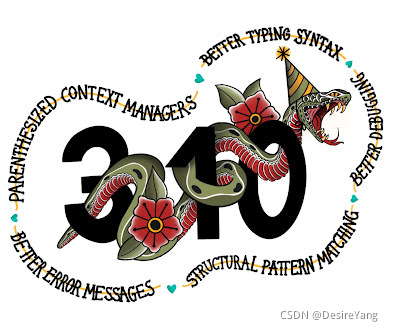Python3.10新特性初体验

注:图片来源
目录
- 结构模式匹配 【PEP 635】
- union类型允许X | Y 【PEP 604】
- 带圆括号的上下文管理器
一、结构模式匹配(新增PEP 635)
如果你熟悉别的语言,你肯定知道switch->case语句,python3.10之前的版本是一直没有这种语法的,但是这一次的更新中3.10+版本开始支持这种结构模式匹配的语法书写了–match->case
1、基本语法
match expression: # 条件,可为任意表达式、变量
case pattern_1: # 模式,待匹配的条件1
... # 需要执行的代码块
case pattern_2: # 模式,待匹配的条件2
... # 需要执行的代码块
case _: # 模式,表示default
... # 需要执行的代码块
2、模式
1. as模式(AS)
def simplify_expr(tokens):
match tokens:
case [('(' | '[') as l, *expr, (')' | ']') as r] if (l + r) in ('()', '[]'):
# 第一个参数得为('(' | '['),取别名为l
# 最后一个参数得为('(' | '['),取别名为r
# 并且需判断(l + r) in ('()', '[]')为True才会进入此代码块执行
print(expr)
case [0, ('+' | '-') as op, right]:
# 第一个参数必须为0
# 第二个参数得为('+' | '-'),取别名为op
# 第三个参数为任意数
# 序列的长度必须为3个
print(op, right)
case [(int() | float()) as value]:
# 序列的长度只能有1个
# 并且,类型只能是int或者float
print(value)
case _:
# 匹配不到则走这里
print("未匹配到")
simplify_expr(['(', "aaa", "bbb", ")"]) # ['aaa', 'bbb']
simplify_expr(['[', "aaa", "bbb", "]"]) # ['aaa', 'bbb']
simplify_expr(['[', "aaa", "bbb", ")"]) # 未匹配到
simplify_expr(['[', "]"]) # []
simplify_expr(['bbb', '[', "]"]) # 未匹配到
simplify_expr([0, "+", 3]) # + 3
simplify_expr([0, "-", 3]) # - 3
simplify_expr([0, "-", 3, 34]) # 未匹配到
simplify_expr([1]) # 1
simplify_expr([1.0]) # 1.0
simplify_expr([1.0, 1]) # 未匹配到
simplify_expr(["aaaa"]) # 未匹配到
2. or模式(|)
def demo(code):
match code:
case 200:
print("200成功了")
case 400 | 404:
print("出问题了")
case (1002 | 1006, 200): # 把两个值组织起来(组织模式)
print("接口请求成功")
case _:
print("匹配不到")
demo(200) # 200成功了
demo(400) # 出问题了
demo(404) # 出问题了
demo((1006, 200)) # 接口请求成功
demo(502) # 匹配不到
3. 文字模式(Literal)
def simplify(expr):
match expr:
case ('+', 0, x):
return x
case ('+' | '-', x, 0):
return x
case ('and', True, x):
return x
case ('and', False, x):
return False
case ('or', False, x):
return x
case ('or', True, x):
return True
case ('not', ('not', x)):
return x
return expr
print(simplify(('+', 0, 12))) # 12
print(simplify(('+', 13, 0))) # 13
print(simplify(('-', 13, 0))) # 13
print(simplify(('and', True, 0))) # 0
print(simplify(('and', False, 0))) # False
print(simplify(('or', False, 1))) # 1
print(simplify(('or', True, 1))) # True
print(simplify(('not', ('not', 23)))) # 23
4. 捕获模式(Capture)
def average(*args):
match args:
case [x, y]:
return (x + y) / 2
case [x]:
return x
case []:
return 0
case [x, y, z]:
return x + y + z
case a:
return sum(a) / len(a)
print(average(1, 2, 3, 4)) # 2.5 ==> a ==> sum(a) / len(a)==> (1+2+3+4)/4 = 2.5
print(average(1, 2)) # 1.5 ==> [x, y] ==> (x+y)/2 ==> (1+2)/2=1.5
print(average(1)) # 1 ==> [x] ==> x=1
print(average()) # 0 ==> [] ==> 0
# 如果传递的是三个元素,则会按照长度进行匹配,跟传字典类型不同
print(average(1, 2, 3)) # 6 ==> [x, y, z] ==> 1+2+3=6
5. 通配符模式(Wildcard)
- _:在前面就表示任意字符
- case _:这里的_在末尾,表示default默认
def is_closed(sequence):
match sequence:
case [_]: # 只有一个元素的序列
return True
case [start, *_, end]: # 至少含有两个元素的序列
return start == end
case _: # 匹配任意类型
return False
print(is_closed(1)) # False ==> _ ==> False
print(is_closed([1])) # True ==> [_] ==> True
print(is_closed([1, 2, 3])) # False ==> [start, *_, end] ==>>1 ==3 ==>False
6. 值模式(value)
class HttpStatus(object):
OK = 200
MOVED_PERMANENTLY = 301
NOT_FOUND = 404
class MimeType(object):
TEXT = "text"
APPL_ZIP = "appl_zip"
def handle_reply(reply):
match reply:
case (HttpStatus.OK, MimeType.TEXT, body):
print(f"请求成功,类型是TEXT,body==>{body}")
case (HttpStatus.OK, MimeType.APPL_ZIP, body):
print(f"请求成功,类型是APPL_ZIP,body==>{body}")
case (HttpStatus.MOVED_PERMANENTLY, new_URI):
print(f"301了,赶紧检查下URI==>{new_URI}")
case (HttpStatus.NOT_FOUND):
print("网站挂了。。。")
handle_reply([200, "text", "dddddd"]) # 请求成功,类型是TEXT,body==>dddddd
handle_reply([200, "appl_zip", "dddddd"]) # 请求成功,类型是APPL_ZIP,body==>dddddd
handle_reply([200, "appl_zip", "dddddd"]) # 请求成功,类型是APPL_ZIP,body==>dddddd
handle_reply([301, "sip:smith@zte.com.cn"]) # 301了,赶紧检查下URI==>sip:smith@zte.com.cn
handle_reply(404) # 网站挂了。。。
7. 组织模式(Group)
使用or模式实现
def demo(code):
match code:
case 200:
print("200成功了")
case 400 | 404:
print("出问题了")
case (1002 | 1006, 200): # 把两个值组织起来(组织模式)
print("接口请求成功")
case _:
print("匹配不到")
demo((1006, 200)) # 接口请求成功
8. 序列模式(Sequence)
def is_closed(sequence):
match sequence:
case [_]: # 只有一个元素的序列
return True
case [start, *_, end]: # 至少含有两个元素的序列
return start == end
case _: # 匹配任意类型
return False
print(is_closed(1)) # False ==> _ ==> False
print(is_closed([1])) # True ==> [_] ==> True
print(is_closed([1, 2, 3])) # False ==> [start, *_, end] ==>>1 ==3 ==>False
9. 映射模式(Mapping)
def change_red_to_blue(json_obj):
match json_obj:
case {'color': ('red' | '#FF0000')}:
json_obj['color'] = 'blue'
case {'children': children}:
for child in children:
change_red_to_blue(child)
color = {"color": "red"}
print(color) # {'color': 'red'}
change_red_to_blue(color)
print(color) # {'color': 'blue'}
# 注意:如果传参是字典,依次从下进行匹配,只要匹配到则不会再往下匹配了
# 如下,color包含color和children两个键,匹配时,匹配到了color就结束了,不会再进行下一步匹配children了
color = {"color": "red", "children": [{"color": "#FF0000"}]}
print(color) # {'color': 'red', 'children': [{'color': '#FF0000'}]}
change_red_to_blue(color)
print(color) # {'color': 'blue', 'children': [{'color': '#FF0000'}]} children中的color则不会被修改
10. 类模式(Class)
class MyClassA(object):
def __init__(self, name) -> None:
self.name = name
def demo(class_):
match class_:
case MyClassA(name="desire"):
print("是desire啊")
case _:
print(class_.name)
demo(MyClassA("ronin")) # ronin ==> _ ==> MyClassA("ronin").name ==> class_.name=ronin
demo(MyClassA("desire")) # 是desire啊 ==> MyClassA(name="desire") ==> print("是desire啊")
3、匹配要注意的顺序
- 当 match 的对象是一个 list 或者 tuple 的时候,需要长度和元素值都能匹配,才能命中,在
捕获模式中体现的有。 - 当 match 的对象是一个 dict 的时候,规则却有所不同,只要 case 表达式中的 key 在所 match 的对象中有存在,即可命中,在
映射模式中体现的有。 - 而当 match 的对象是类对象时,匹配的规则是,跟 dict 有点类似,只要对象类型和对象的属性有满足 case 的条件,就能命中,在
类模式中体现的有。
二、union类型允许X | Y (PEP 604)
新的语法union接受函数,变量和参数注释。
1、简单的语法
# before
from typing import List, Union, Optional
def f(list: List[Union[int, str]], param: Optional[int]) -> Union[float, str]:
pass
# now 更加简洁了
from typing import List
def f(list: List[int | str], param: int | None) -> float | str:
pass
2、typing.Union 和 | 是等价的
int | str == typing.Union[int, str] # True
3、顺序是没有要求的
(int | str) == (str | int) # True
(int | str | float) == typing.Union[str, float, int] # True
4、isinstance和issubclass支持
isinstance(5, int | str) # True
isinstance("aaa", int | str) # True
isinstance(1.22, int | str) # False
issubclass(bool, int | float) # True
isinstance(None, int | None) # True
isinstance(42, None | int) # True
三、带圆括号的上下文管理器
已支持使用外层圆括号来使多个上下文管理器可以连续多行地书写。 这允许将过长的上下文管理器集能够以与之前 import 语句类似的方式格式化为多行的形式。
一下四种格式都是支持的
# 之前的格式不影响使用
with open("readme.md", 'r') as f:
pass
with (open("readme.md", 'r') as f):
pass
with (open("readme.md", 'r') as f1,
open("readme.md", 'r') as f2):
pass
with (open("readme.md", 'r'),
open("readme.md", 'r') as f2):
pass
with (open("readme.md", 'r'),
open("readme.md", 'r'),
):
pass